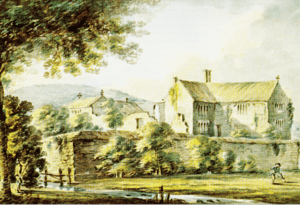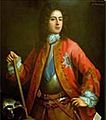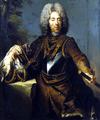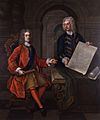John Churchill, 1st Duke of Marlborough facts for kids
Quick facts for kids
The Duke of Marlborough
|
|
|---|---|

Portrait by Adriaen van der Werff
|
|
| First Lord of the Treasury | |
| In office 8 May 1702 – 11 August 1710 |
|
| Monarch | Anne |
| Preceded by | The Earl of Carlisle |
| Succeeded by | The Earl Poulett |
| Personal details | |
| Born | 26 May 1650 Ashe House, Devon, England |
| Died | 16 June 1722 (aged 72) Windsor Lodge, Berkshire, England, Kingdom of Great Britain |
| Spouse | Sarah Jennings |
| Children | 7, including: Henrietta Godolphin, 2nd Duchess of Marlborough Anne Spencer, Countess of Sunderland John Churchill, Marquess of Blandford |
| Parents | Winston Churchill Elizabeth Drake |
| Signature | |
| Military service | |
| Allegiance | |
| Branch/service | English army British army |
| Rank | General |
| Commands | Commander-in-Chief of the Forces Master-General of the Ordnance |
| Battles/wars | Monmouth Rebellion |
| Awards | Knight of the Order of the Garter |
General John Churchill, 1st Duke of Marlborough, 1st Prince of Mindelheim, 1st Count of Nellenburg, Prince of the Holy Roman Empire was an English soldier and statesman whose career spanned the reigns of five monarchs.
Early life
Churchill was the second but eldest-surviving son of Sir Winston Churchill of Glanvilles Wootton, Dorset, and Elizabeth Drake, whose family came from Ash, in Devon. Winston served with the Royalist Army in the Wars of the Three Kingdoms; he was heavily fined for doing so, forcing his family to live at Ash House with his mother-in-law.
Only five of their children survived infancy: Arabella, who was the eldest; followed by John; George; and Charles. Another brother, Theobald, died in 1685.
After the 1660 Restoration of Charles II, Winston became Member of Parliament for Weymouth and from 1662 served as Commissioner for Irish Land Claims in Dublin. On returning to London in 1663, he was knighted and received a position at Whitehall, with John attending St Paul's School.
The family fortune was made in 1665 when Arabella Churchill became maid of honour to Anne Hyde. This led to appointments for her brothers; John was appointed page to James, Duke of York, and in September 1667 made an ensign in the Foot Guards.
Career
Through the 1670s and early 1680s, Churchill earned military and political advancement through his courage and diplomatic skill. Churchill's role in defeating the Monmouth Rebellion in 1685 helped secure James on the throne, yet just three years later he abandoned his Catholic patron for the Protestant Dutchman, William of Orange. Honoured for his services at William's coronation with the earldom of Marlborough, he served with further distinction in the early years of the Nine Years' War, but persistent charges of Jacobitism brought about his fall from office and temporary imprisonment in the Tower. It was not until the accession of Queen Anne in 1702 that Marlborough reached the peak of his powers and secured his fame and fortune.
His marriage to the hot-tempered Sarah Jennings – Anne's intimate friend – ensured Marlborough's rise, first to the Captain-Generalcy of British forces, then to a Dukedom. Becoming leader of Allied forces during the War of the Spanish Succession, his victories on the fields of Blenheim (1704), Ramillies (1706), Oudenarde (1708), and Malplaquet (1709), ensured his place in history as one of Europe's great generals.
His wife's stormy relationship with the Queen, and her dismissal from court, was central to his own fall. Incurring Anne's disfavour, and caught between Tory and Whig factions, Marlborough, who had brought glory and success to Anne's reign, was forced from office and went into self-imposed exile. He returned to England and to influence under the House of Hanover with the accession of George I to the British throne in 1714.
Marlborough's ambition made him the richest of all Anne's subjects. His family connections wove him into European politics. His leadership of the allied armies consolidated Britain's emergence as a front-rank power. He successfully maintained unity among the allies, thereby demonstrating his diplomatic skills.
Throughout ten consecutive campaigns during the Spanish Succession war, Marlborough held together a conflicting alliance through his sheer force of personality and raised the standing of British arms to a level not known since the Middle Ages. His victories allowed Britain to rise from a minor to a major power, ensuring the country's growing prosperity throughout the 18th century.
As an administrator Marlborough was also without peer; his attention to detail meant his troops rarely went short of supply – when his army arrived at its destination it was intact and in a fit state to fight. This concern for the welfare of the common soldier together with his ability to inspire trust and confidence, and his willingness to share the dangers of battle, often earned him admiration from his men – "The known world could not produce a man of more humanity", observed Corporal Matthew Bishop.
It was this range of abilities that makes Marlborough outstanding. Even his old adversaries recognised the Duke's qualities. His success was made possible because of his enormous reserves of stamina, willpower and self-discipline; his ability to hold together the Alliance against France, made possible by his victories, can hardly be overestimated.
Death
While living at Windsor Lodge Churchill suffered a stroke in June 1722, not long after his 72nd birthday. In the presence of his wife Sarah and two surviving daughters, the 1st Duke of Marlborough died. He was initially buried in the vault at the east end of Henry VII's chapel in Westminster Abbey, but following instructions left by Sarah, who died in 1744, Marlborough was moved to be by her side lying in the vault beneath the chapel at Blenheim.
Personal life
Sometime around 1675, Churchill met Sarah Jennings, who came from a similar background of minor Royalist gentry, ruined by the war. The family moved to London after her father died and in 1673, Sarah and her sister Frances joined the household of Mary of Modena, James' second Catholic wife. Despite opposition from his father, who wanted him to marry the wealthy Catherine Sedley, Churchill married Sarah in the winter of 1677–78, helped by Mary.
The couple had five children who survived to adulthood: Henrietta Churchill, 2nd Duchess of Marlborough, Lady Anne Churchill, John Churchill, Marquess of Blandford, Elizabeth, and Mary.
Titles
| Title | Years | Followed by |
|---|---|---|
| Duke of Marlborough | 1702–1722 | Henrietta Godolphin, 2nd Duchess of Marlborough |
| Earl of Marlborough | 1689–1722 | |
| Baron Churchill of Sandridge | 1685–1722 | |
| Lord Churchill of Eyemouth | 1682–1722 | extinct |
| Prince of Mindelheim | 1705–1714 | Maximilian II Emanuel, Elector of Bavaria |
Family tree
| Spencer-Churchill family tree of the Dukes of Marlborough | |||||||||||||||||||||||||||||||||||||||||||||||||||||||||||||||||||||||||||||||||||||||||||||||||||||||||||||||||||||||||||||||||||||||||||||||||||||||||||||||||||||||||||||||||||||||||||||||||||||||||||||||||||||||||||||||||||||||||||||||||||||||||||||||||||||||||||||||||||||||||||||||||||||||||||||||||||||||||||||||||||||||||||||||||||||||||||||||||||||||||||||||||||||||||||||||||||||||||||||||||||||||||||||||||||||||||||||||||||||||||||||||||||||||||||||||||||||||||||||||||||||||||||||||||||||||||||||||||||||||||||||||||||||||||||||||||||||||||||||||||||||||||||||||||||||||||||||||||||||||||||||||||||||||||||||||||||||||||||||||||||||||||||||||||||||||||||||||||||||||||||||||||||||||||||||||||||||||||||||||||||||||||||||||||||||||||||||||||||||||||||||||||||||||||||||||||||||||||||||||||||||||||||||||||||||||||||||||||||||||||||||||||||||||||||||||||||||||||||||||||||||||||||||||||||||||||||||||||||||||||||||||||||||||||||||||||||||||||||||||||||||||||||||||||||||||||||||||||||||||
|---|---|---|---|---|---|---|---|---|---|---|---|---|---|---|---|---|---|---|---|---|---|---|---|---|---|---|---|---|---|---|---|---|---|---|---|---|---|---|---|---|---|---|---|---|---|---|---|---|---|---|---|---|---|---|---|---|---|---|---|---|---|---|---|---|---|---|---|---|---|---|---|---|---|---|---|---|---|---|---|---|---|---|---|---|---|---|---|---|---|---|---|---|---|---|---|---|---|---|---|---|---|---|---|---|---|---|---|---|---|---|---|---|---|---|---|---|---|---|---|---|---|---|---|---|---|---|---|---|---|---|---|---|---|---|---|---|---|---|---|---|---|---|---|---|---|---|---|---|---|---|---|---|---|---|---|---|---|---|---|---|---|---|---|---|---|---|---|---|---|---|---|---|---|---|---|---|---|---|---|---|---|---|---|---|---|---|---|---|---|---|---|---|---|---|---|---|---|---|---|---|---|---|---|---|---|---|---|---|---|---|---|---|---|---|---|---|---|---|---|---|---|---|---|---|---|---|---|---|---|---|---|---|---|---|---|---|---|---|---|---|---|---|---|---|---|---|---|---|---|---|---|---|---|---|---|---|---|---|---|---|---|---|---|---|---|---|---|---|---|---|---|---|---|---|---|---|---|---|---|---|---|---|---|---|---|---|---|---|---|---|---|---|---|---|---|---|---|---|---|---|---|---|---|---|---|---|---|---|---|---|---|---|---|---|---|---|---|---|---|---|---|---|---|---|---|---|---|---|---|---|---|---|---|---|---|---|---|---|---|---|---|---|---|---|---|---|---|---|---|---|---|---|---|---|---|---|---|---|---|---|---|---|---|---|---|---|---|---|---|---|---|---|---|---|---|---|---|---|---|---|---|---|---|---|---|---|---|---|---|---|---|---|---|---|---|---|---|---|---|---|---|---|---|---|---|---|---|---|---|---|---|---|---|---|---|---|---|---|---|---|---|---|---|---|---|---|---|---|---|---|---|---|---|---|---|---|---|---|---|---|---|---|---|---|---|---|---|---|---|---|---|---|---|---|---|---|---|---|---|---|---|---|---|---|---|---|---|---|---|---|---|---|---|---|---|---|---|---|---|---|---|---|---|---|---|---|---|---|---|---|---|---|---|---|---|---|---|---|---|---|---|---|---|---|---|---|---|---|---|---|---|---|---|---|---|---|---|---|---|---|---|---|---|---|---|---|---|---|---|---|---|---|---|---|---|---|---|---|---|---|---|---|---|---|---|---|---|---|---|---|---|---|---|---|---|---|---|---|---|---|---|---|---|---|---|---|---|---|---|---|---|---|---|---|---|---|---|---|---|---|---|---|---|---|---|---|---|---|---|---|---|---|---|---|---|---|---|---|---|---|---|---|---|---|---|---|---|---|---|---|---|---|---|---|---|---|---|---|---|---|---|---|---|---|---|---|---|---|---|---|---|---|---|---|---|---|---|---|---|---|---|---|---|---|---|---|---|---|---|---|---|---|---|---|---|---|---|---|---|---|---|---|---|---|---|---|---|---|---|---|---|---|---|---|---|---|---|---|---|---|---|---|---|---|---|---|---|---|---|---|---|---|---|---|---|---|---|---|---|---|---|---|---|---|---|---|---|---|---|---|---|---|---|---|---|---|---|---|---|---|---|---|---|---|---|---|---|---|---|---|---|---|---|---|---|---|---|---|---|---|---|---|---|---|---|---|---|---|---|---|---|---|---|---|---|---|---|---|---|---|---|---|---|---|---|---|---|---|---|---|---|---|---|---|---|---|---|---|---|---|---|---|---|---|---|---|---|---|---|---|---|---|---|---|---|---|---|---|---|---|---|---|---|---|---|---|---|---|---|---|---|---|---|---|---|---|---|---|---|---|---|---|---|---|---|---|---|---|---|---|---|---|---|---|---|---|---|---|---|---|---|---|---|---|---|---|---|---|---|---|---|---|---|---|---|---|---|---|---|---|---|---|---|---|---|---|---|---|---|---|---|---|---|---|---|---|---|---|---|---|---|---|---|---|---|---|---|---|---|---|---|---|---|---|---|---|---|---|---|---|---|---|---|---|---|---|---|---|---|---|---|---|---|---|---|---|---|---|---|---|---|---|---|---|---|---|---|---|---|---|---|---|---|---|---|---|---|---|---|---|---|---|---|---|---|---|---|---|---|---|---|---|---|---|---|---|---|---|---|---|---|---|---|---|---|---|---|---|---|---|---|---|---|---|---|---|---|---|---|---|---|---|---|---|---|---|---|---|---|---|---|---|---|---|---|---|---|---|---|
|
|||||||||||||||||||||||||||||||||||||||||||||||||||||||||||||||||||||||||||||||||||||||||||||||||||||||||||||||||||||||||||||||||||||||||||||||||||||||||||||||||||||||||||||||||||||||||||||||||||||||||||||||||||||||||||||||||||||||||||||||||||||||||||||||||||||||||||||||||||||||||||||||||||||||||||||||||||||||||||||||||||||||||||||||||||||||||||||||||||||||||||||||||||||||||||||||||||||||||||||||||||||||||||||||||||||||||||||||||||||||||||||||||||||||||||||||||||||||||||||||||||||||||||||||||||||||||||||||||||||||||||||||||||||||||||||||||||||||||||||||||||||||||||||||||||||||||||||||||||||||||||||||||||||||||||||||||||||||||||||||||||||||||||||||||||||||||||||||||||||||||||||||||||||||||||||||||||||||||||||||||||||||||||||||||||||||||||||||||||||||||||||||||||||||||||||||||||||||||||||||||||||||||||||||||||||||||||||||||||||||||||||||||||||||||||||||||||||||||||||||||||||||||||||||||||||||||||||||||||||||||||||||||||||||||||||||||||||||||||||||||||||||||||||||||||||||||||||||||||||||
Arms
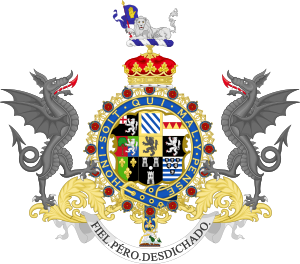 |
|
Images for kids
-
Sarah Churchill, Duchess of Marlborough; attributed to Godfrey Kneller
-
Marlborough in his thirties, attributed to John Riley. The Star of the Order of the Garter was added after 1707.
-
Princess Anne 1683 by Willem Wissing. When Mary died childless in 1694 (O.S.), Anne, her sister, became heir apparent.
-
Sidney Godolphin, Lord Treasurer, Chief Minister and fellow Tory friend of Marlborough
-
Europe in 1700; Marlborough fought principally in the Low Countries.
-
Marlborough at the Battle of Ramillies, 1706
-
Robert Harley by Jonathan Richardson, c. 1710. Harley became Marlborough's nemesis.
-
Marlborough at the Battle of Oudenaarde, 1708
-
Marlborough and John Armstrong his chief engineer, possibly by Enoch Seeman. Depicted discussing the Siege of Bouchain.
-
John Vanbrugh's Blenheim Palace. Begun in 1705, but plagued by financial troubles, this "pile of stones", as the Duchess resentfully called it, was finally completed in 1733.
-
Blenheim Column of Victory on the grounds of the Blenheim estate, Oxfordshire
See also
 In Spanish: John Churchill, I duque de Marlborough para niños
In Spanish: John Churchill, I duque de Marlborough para niños


